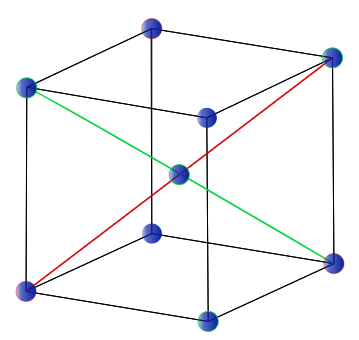
In a body centered cubic cell, an atom at the body center is shared by:
A.$1$ unit cell
B.$2$ unit cell
C.$3$ unit cell
D.$4$ unit cell
Answer
570.6k+ views
Hint:Unit cell: It is defined as the smallest repeating unit in the crystal lattice or you can say the building block of a crystal as like a cell is the unit cell of the body. They are of three types: (I) primitive cubic unit cell, (II) Body-centered cubic unit cell (III) Face-centered cubic unit cell.
Complete step by step answer:
Unit of crystal: It is defined as the repeating unit in the crystal. They are of three types: (I) primitive cubic unit cell, (II) Body-centered cubic unit cell (III) Face-centered cubic unit cell.
Primitive cubic unit cell: In this unit cell, atoms are present only at the corners of the cube. We know that there are eight corners in a cube. So one atom is shared by right corners. So the contribution of an atom in one corner is $\dfrac{1}{8}$. The number of atoms present in a primitive cubic unit cell is one.
Body-centered cubic unit cell: In this unit cell, atoms are present at the centre and corners of the cube. We know that there is only one centre in a cube. So one atom is completely present there. And one atom is contributing to the eight corners. So the total number of atoms present in a Body-centered cubic unit cell is $2$.

Diagram showing Body Centred cubic cell
Face-centered cubic unit cell: In this unit cell, atoms are present at corners and at the face centres of the cube. There are a total six faces in a cube. So one atom contributes to two face centres i.e. one atom is half. And one atom contributing to all eight corners of the cube. So there are four atoms present in the face-centered cubic unit cell.
So the number of atoms present in the body-centered unit cell is two. And the atom at the centre is shared by only one unit cell.
So option A is the correct option.
Note: In primitive unit cell total number of atoms present is one, in body-centred cubic unit cell total number of atoms present is two and in face-centered cubic unit cell total number of atoms present is four.
Complete step by step answer:
Unit of crystal: It is defined as the repeating unit in the crystal. They are of three types: (I) primitive cubic unit cell, (II) Body-centered cubic unit cell (III) Face-centered cubic unit cell.
Primitive cubic unit cell: In this unit cell, atoms are present only at the corners of the cube. We know that there are eight corners in a cube. So one atom is shared by right corners. So the contribution of an atom in one corner is $\dfrac{1}{8}$. The number of atoms present in a primitive cubic unit cell is one.
Body-centered cubic unit cell: In this unit cell, atoms are present at the centre and corners of the cube. We know that there is only one centre in a cube. So one atom is completely present there. And one atom is contributing to the eight corners. So the total number of atoms present in a Body-centered cubic unit cell is $2$.

Diagram showing Body Centred cubic cell
Face-centered cubic unit cell: In this unit cell, atoms are present at corners and at the face centres of the cube. There are a total six faces in a cube. So one atom contributes to two face centres i.e. one atom is half. And one atom contributing to all eight corners of the cube. So there are four atoms present in the face-centered cubic unit cell.
So the number of atoms present in the body-centered unit cell is two. And the atom at the centre is shared by only one unit cell.
So option A is the correct option.
Note: In primitive unit cell total number of atoms present is one, in body-centred cubic unit cell total number of atoms present is two and in face-centered cubic unit cell total number of atoms present is four.
Recently Updated Pages
Master Class 12 Business Studies: Engaging Questions & Answers for Success

Master Class 12 Economics: Engaging Questions & Answers for Success

Master Class 12 English: Engaging Questions & Answers for Success

Master Class 12 Maths: Engaging Questions & Answers for Success

Master Class 12 Social Science: Engaging Questions & Answers for Success

Master Class 12 Chemistry: Engaging Questions & Answers for Success

Trending doubts
What are the major means of transport Explain each class 12 social science CBSE

Which are the Top 10 Largest Countries of the World?

Draw a labelled sketch of the human eye class 12 physics CBSE

Explain sex determination in humans with line diag class 12 biology CBSE

The pH of the pancreatic juice is A 64 B 86 C 120 D class 12 biology CBSE

Explain sex determination in humans with the help of class 12 biology CBSE




